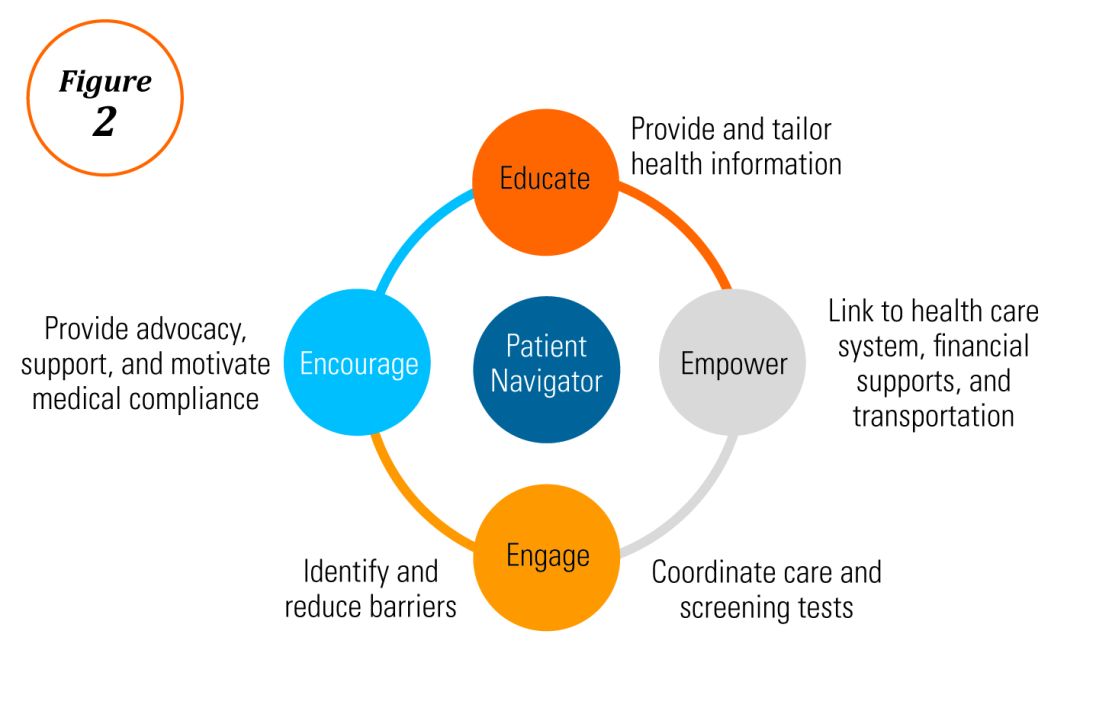How can we intervene successfully?
Characterization of barriers is important because it promotes the development of targeted interventions. Intervention models include community engagement programs, incorporation of fecal occult testing, and patient navigator programs.45-47 In response to the alarming disparity in CRC screening rates in Latino communities, several interventions have been set in motion in different clinical scenarios, which include patient navigation and a focus on patient education.
Patient navigators facilitate the screening process at different stages, including providing information that is easy to understand by patients, translating when patients are not proficient in English, addressing any concerns they may have about the procedure, and reminding patients about their appointments via phone calls or other means (Figure 2). Trials evaluating the effect of patient navigators in Hispanic populations have resulted in anywhere from a modest 11% to a robust 56% increase in screening.48-50 In facilities serving a large number of Latino patients with low socioeconomic status, low-cost interventions, such as mailing information about CRC screening to all eligible patients, increased the screening rate from 12% to 28%.51 It has been shown that using bilingual and bicultural staff, language-appropriate material, and face-to-face encounters in a community setting helped recruit Chinese Americans into CRC screening trials.52 Similarly, an activation educational program consisting of a video and brochure that actively encouraged patients to ask their primary care physicians about CRC screening resulted in a 10% increase in screening rates.53Randomized trials have shown that outreach efforts and patient navigation increase CRC screening rates in AAs.48,54,55 Studies evaluating the effects of print-based educational materials on improving screening showed improvement in screening rates, decreases in cancer-related fatalistic attitudes, and patients had a better understanding of the benefits of screening as compared with the cost associated with screening and the cost of advanced disease.56 Similarly, the use of touch-screen computers that tailor informational messages to decisional stage and screening barriers increased participation in CRC screening.57 Including patient navigators along with printed education material was even more effective at increasing the proportion of patients getting colonoscopy screening than providing printed material alone, with more-intensive navigation needed for individuals with low literacy.58 Grubbs et al.reported the success of their patient navigation program, which included wider comprehensive screening and coverage for colonoscopy screening.59 In AAs, they estimated an annual reduction of CRC incidence and mortality of 4,200 and 2,700 patients, respectively.
Among immigrants, there is an increased likelihood of CRC screening in those immigrants with a higher number of primary care visits.60 The intersection of culture, race, socioeconomic status, housing enclaves, limited English proficiency, low health literacy, and immigration policy all play a role in immigrant health and access to health care.61
Therefore, different strategies may be needed for each immigrant group to improve CRC screening. For this group of patients, efforts aimed at mitigating the adverse effects of national immigration policies on immigrant populations may have the additional consequence of improving health care access and CRC screening for these patients.
Data gaps still exist in our understanding of patient perceptions, perspectives, and barriers that present opportunities for further study to develop long-lasting interventions that will improve health care of underserved populations. By raising awareness of the barriers, physicians can enhance their own self-awareness to keenly be attuned to these challenges as patients cross their clinic threshold for medical care.





